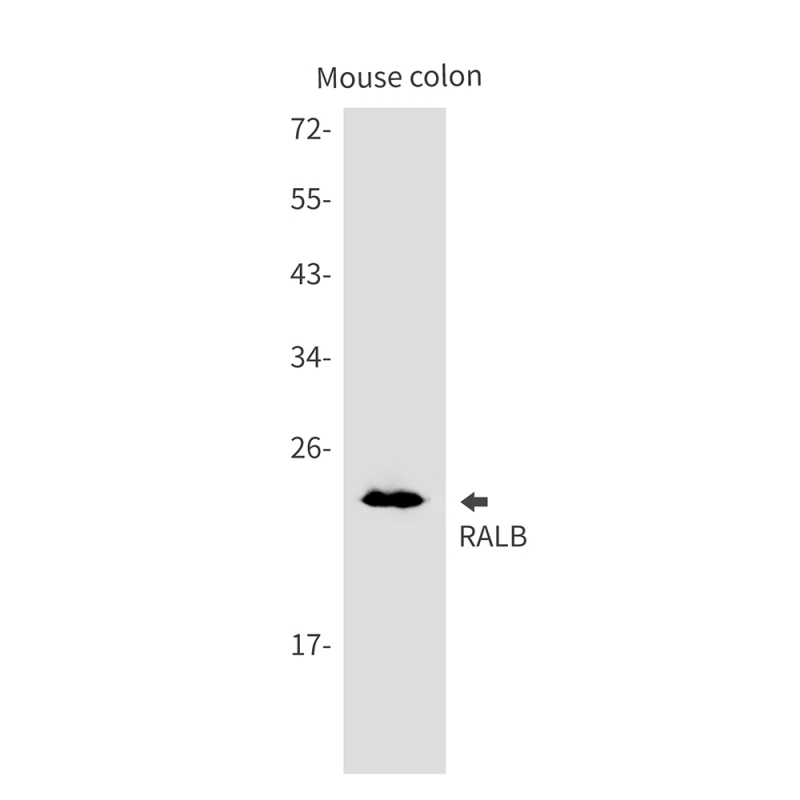

| WB | 1/500-1/1000 | Human,Mouse,Rat |
| IF | 1/20 | Human,Mouse,Rat |
| IHC | 咨询技术 | Human,Mouse,Rat |
| ICC | 技术咨询 | Human,Mouse,Rat |
| FCM | 咨询技术 | Human,Mouse,Rat |
| Elisa | 咨询技术 | Human,Mouse,Rat |
| Aliases | Ras-related protein Ral-B |
| Entrez GeneID | 5899 |
| WB Predicted band size | Calculated MW: 23 kDa; Observed MW: 23 kDa |
| Host/Isotype | Rabbit IgG |
| Antibody Type | Primary antibody |
| Storage | Store at 4°C short term. Aliquot and store at -20°C long term. Avoid freeze/thaw cycles. |
| Species Reactivity | Human,Mouse |
| Immunogen | A synthetic peptide of human RALB |
| Formulation | Purified antibody in TBS with 0.05% sodium azide,0.05%BSA and 50% glycerol. |
+ +
以下是关于RALB抗体的3篇代表性文献的简要概括(文献信息为模拟示例,仅供参考):
---
1. **文献名称**:Targeting RALB signaling through a monoclonal antibody inhibits tumor invasion
**作者**:Smith J, et al.
**摘要**:研究开发了一种靶向RALB的单克隆抗体,证实其通过阻断RALB与下游效应蛋白的相互作用,显著抑制癌细胞迁移和侵袭,为抗转移治疗提供新策略。
---
2. **文献名称**:RALB-specific antibody reveals its role in autophagy regulation
**作者**:Chen H, et al.
**摘要**:利用特异性抗体敲低RALB,发现其通过mTOR通路调控自噬过程,影响肿瘤细胞存活,提示RALB抗体在探索耐药机制中的工具价值。
---
3. **文献名称**:Diagnostic potential of RALB phosphorylation-specific antibody in breast cancer
**作者**:Wang Y, et al.
**摘要**:开发了针对磷酸化RALB的抗体,临床样本分析显示其高表达与乳腺癌转移正相关,可作为潜在生物标志物。
---
**备注**:实际文献需通过学术数据库(如PubMed、Web of Science)检索,建议结合关键词“RALB antibody”“RALB inhibitor”或“RALB signaling”获取最新研究。
RALB (RAS-like proto-oncogene B) is a small GTPase belonging to the RAS superfamily, which plays critical roles in regulating diverse cellular processes, including vesicle trafficking, cytoskeletal reorganization, and cell proliferation. As a member of the RAL subfamily, RALB shares structural homology with RALA but exhibits distinct functional roles, particularly in oncogenesis and immune response. RALB cycles between an active GTP-bound state and an inactive GDP-bound state, interacting with downstream effectors like Exo84 and Sec5 to mediate exocytosis, membrane trafficking, and signal transduction.
RALB is implicated in cancer progression, where its dysregulation promotes tumor invasion, metastasis, and resistance to apoptosis. Unlike RALA, RALB activation is linked to immune modulation, influencing pathways such as the STING (stimulator of interferon genes) pathway to regulate antiviral responses and NF-κB-driven inflammation. Its role in innate immunity also involves interactions with Toll-like receptors (TLRs) and autophagy machinery.
RALB-specific antibodies are vital tools for studying its expression, localization, and activation in cellular contexts. They enable detection via techniques like Western blotting, immunofluorescence, and immunohistochemistry, aiding research into RALB's pathological mechanisms. Therapeutic strategies targeting RALB, including inhibitory antibodies or small molecules, are under exploration for cancers and immune disorders. These antibodies help elucidate RALB's crosstalk with oncogenic RAS pathways and its potential as a biomarker or therapeutic target, highlighting its dual role in both driving malignancy and modulating immune surveillance.
×